What to do if the toilet bowl is flowing
The operation of plumbing is often associated with the appearance of some malfunctions in the process of work, they can be caused by a variety of reasons, therefore, different ways to solve them. Consider a common problem when the toilet bowl is flowing - what to do and how to solve the problem, our article will tell. We will figure out how to repair the system in one way or another.

The main types of leaks
Let us see what problems mainly arise during the operation:
| Misses a petal or a pear | The most common problem that occurs for many reasons, from poor water quality to normal wear and tear. |
| Flowing through the overflow | This reason is caused by a malfunction of the float - it is either poorly adjusted or the stem is bent. Sometimes the tightness of the structure is broken, which also leads to failures. |
| The leak between the cistern and the toilet | Another unpleasant breakdown, which, however, is quite easy to fix (we will describe below as) |
| Leaks on connections | Caused by loose clamping or loss of elasticity by seals. |
| Water seeps through the tank to the toilet bolts | Everything is easiest: you must tighten the nuts or replace the sealing elements |
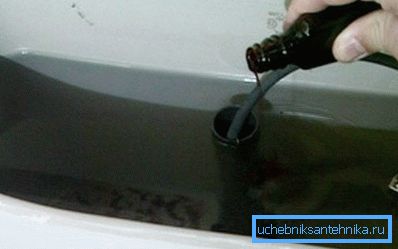
Description of the repair of some faults
We divide all leaks into several groups and analyze how to fix them quickly and at no extra cost.
Intake system faults
If water constantly flows in the toilet cistern, it means that the inlet valve failed, there could be several main reasons:
- The float mount lever is skewed - in this case, you can simply straighten it manually, so that it becomes absolutely smooth.
- If the body of the float is damaged and water penetrates it, then a replacement should be made.. If this is not possible, then you can either solder the float, or seal it with durable adhesive tape.
- In cases where a breakdown is caused by a malfunction of the float valve in the tank, it is easiest to replace it., especially since the price of this node is low.
It should be noted that with a constant flow of water into the tank, water from the tank flows into the toilet through the overflow, you should not immediately check the exhaust system, it is better to first look inside the system.
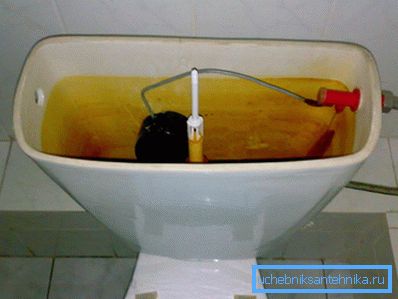
Failures in the exhaust system
In this case, there may be many reasons, consider how to repair the toilet bowl if it is flowing:
- The membrane is damaged in the siphon - in this case the system is disassembled, the node is disconnected from the lever and removed. Further from it the membrane gets, and the similar product is put.
Note! It is advisable to pick up the membrane after removing the old one, so the option of buying the wrong product is excluded.
- Another typical case is when the pear has lost its elasticity and does not provide adequate compaction. This is due to the long period of operation and the loss of rubber elasticity. There is only one way to solve it - replacing an element with a new one; it is easy to do it yourself without any special tool.

- A pear sits on a petal or on a special saddle; over time, the surface may become covered with lime or rust. If the rubber ring is worn out, it should be replaced, and if the metal seat is coated with bloom, it should be cleaned with a metal brush or sandpaper.
- Another reason why the toilet cistern flows is the weakening of the attachment of the overflow base. It is clamped with a nut, which may loosen over time. To solve this problem, you must detach the tank and tighten the mount.
- What to do if all seals are in order, but the water is still constantly flowing? Most likely, the reason lies in the offset of the button height adjuster, with the result that the valve is higher than the drain hole. To solve this problem is quite simple, since the position of the button changes very easily and quickly.
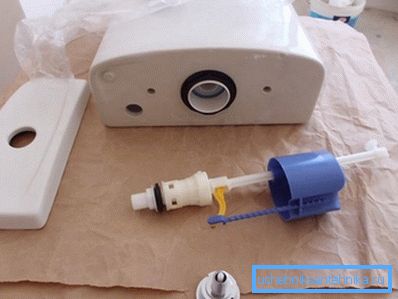
Other faults
But leaks can be caused not only by malfunctioning valves, but also by other causes.
Consider the most common ones:
- If water flows between the cistern and the toilet bowl, the most frequent reason is the wear of the gasket or, as it is also called, the toilet seat cuff. It is a thick rubber ring that can move (in which case it needs to be fixed) or loosen (in this case it is necessary to tighten the mounting bolts). Sometimes rubber simply loses its properties, and only replacing an item with a new one can help.
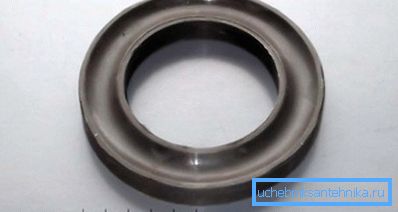
- Repairing a toilet bowl when flowing from under a tank may involve the replacement of sealing elements in the form of conical washers. They prevent the penetration of water through the holes for coupling bolts, and when they warp or loss of elasticity will be observed to flow, and it can be very strong.
Tip! When installing seals for connecting bolts, it is necessary to carefully monitor their position, they should stand straight and be located in the center of the holes.
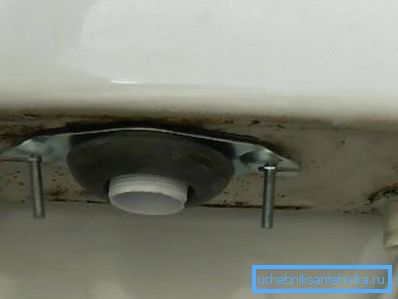
- Another problem - the appearance of cracks in the tank, most often they appear near the mounting holes. The solution to the problem is to remove the container, dry it and seal it with a special sealing compound. After this, it is necessary to wait for the solution to dry, and the tank can be installed in place, the main thing is not to squeeze the mount during installation, otherwise ceramics may collapse completely.
- Sometimes the problem lies in the attachment of flexible liner to the toilet fittings. In this case, it is enough just to tighten it, and if the fastening nut has burst (which is also not uncommon), then the connection is replaced completely. Its price is low, so the repair will not be very expensive.
With the traditional options, we figured out, but what to do if the toilet bowl is flowing?
Due to the features of the device, the work has its differences:
- Valve check is performed in the same way as described above. Systems, as a rule, are almost the same and there are no fundamental differences. The problem is that the container is located behind the installation panel, and sometimes a leak can be noticed not immediately.
- A feature of these tanks is that they are made of plastic, and when cracks appear, they can be simply sealed with a special waterproof compound. All the features of this work will tell the instructions on the packaging.
Conclusion
It doesn’t matter if the toilet bowl is flowing with a button or a handle, the malfunctions are not very different, and their elimination is similar. The video in this article will help to familiarize with some features of the works in more detail.